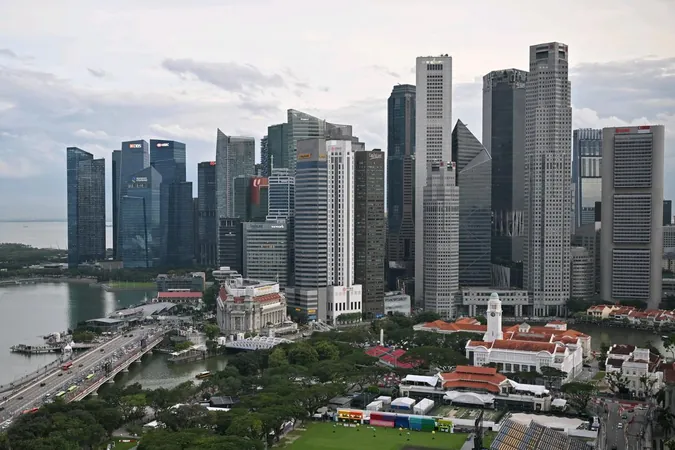
Crucial Economic Trends to Monitor for Singapore in 2025
2025-01-01
Author: Mei
SINGAPORE – As we look ahead to 2025, Singapore is set to navigate through a tumultuous economic landscape characterized by challenges such as the US-China trade conflict, heightened geopolitical tensions, and ongoing market volatility. Experts predict that these factors could hinder the country’s economic growth, resulting in a forecasted real gross domestic product (GDP) growth of only 1 to 3 percent, a decline from the 4 percent growth estimated for 2024 by Prime Minister Lawrence Wong.
1. Tensions from the Trade War
A primary source of uncertainty in Singapore’s economic outlook is the potential implementation of steep tariffs by the new US administration. As President-elect Donald Trump prepares to take office, he has pledged to impose tariffs of up to 20 percent on various trading partners and even greater increases for China. While Singapore may evade these tariffs directly, the ripple effects could lead to increased import prices globally, dampen demand, and lower trade volumes—all detrimental for an export-dependent economy like Singapore.
2. Impact from a Slowing China
Singapore’s economy remains closely tied to that of China, which is anticipated to see a decrease in growth from 5.2 percent in 2023 to 4.5 percent in 2025. Contributing factors include diminished domestic consumption following government crackdowns in real estate and technology and rising unemployment, causing a knock-on effect on neighboring economies reliant on Chinese imports.
3. Inflation and Interest Rate Challenges
Higher tariffs may drive inflation upward, complicating monetary policy management for central banks in Asia. Although inflation had seen a decline recently, the expectation of only modest US rate cuts in 2025 may pressure the Monetary Authority of Singapore (MAS) to maintain a careful balance, as a stronger Singapore dollar could hinder exports further.
4. The Resilient US Dollar
In a climate of economic uncertainty, the US dollar is likely to attract investors as a safe haven, complicating the dynamics for currencies globally. A strengthened dollar means higher import costs for Singapore and may push local central banks to reconsider their easing strategies as inflation pressures rise.
5. Volatility in Financial Markets
Concerns are growing regarding the sustainability of the US stock rally, especially amidst rising valuations seen with tech giants. The potential for a market sell-off could prompt a flight to safety, further exacerbating economic challenges in Asia, including increased inflation and reduced growth.
6. Geopolitical Conflicts
Worsening geopolitical conditions, notably in the Middle East and Ukraine, could significantly impact global investor sentiment and disrupt supply chains, affecting trade volumes crucial to Singapore’s economy. Around one-third of executives anticipate that geopolitical issues will be among the most substantial disruptors in 2025.
7. Commodity Prices on the Rise
Despite recent price caps due to slower growth in China, emerging geopolitical tensions in 2025 could lead to an uptick in international energy and food prices. Tariffs may further contribute to rising costs in these essential commodities.
8. Supply Chain Adjustments
As the fallout from the US-China trade war continues, Singapore remains an attractive destination for semiconductor investments, seeking to avoid entanglements in trade disputes. However, scrutiny over shipments could lead to delays, especially from countries manufacturing goods that utilize significant Chinese components.
9. The Tech War Intensifies
The ongoing semiconductor conflict may deter new investments as companies assess their vulnerability to U.S. technology restrictions. This could have concerning implications for Singapore's growing tech sector, thrusting it into a precarious position amid global supply chain disruptions.
10. Risks for Emerging Markets
Emerging markets with heavy debt burdens, particularly in Southeast Asia, are particularly vulnerable to reduced demand from China. As major economies lean towards protectionist policies, enhanced trade uncertainties could spell more significant economic struggles, leading to increased volatility in asset markets.
As Singapore navigates through these complex economic tides in 2025, stakeholders must remain vigilant and adaptable. The convergence of trade disputes, inflation risks, and geopolitical instability poses both challenges and opportunities as the Lion City positions itself within an evolving global economy. Will Singapore emerge stronger from these hurdles, or will it face a continual uphill battle? Only time will tell!





 Brasil (PT)
Brasil (PT)
 Canada (EN)
Canada (EN)
 Chile (ES)
Chile (ES)
 Česko (CS)
Česko (CS)
 대한민국 (KO)
대한민국 (KO)
 España (ES)
España (ES)
 France (FR)
France (FR)
 Hong Kong (EN)
Hong Kong (EN)
 Italia (IT)
Italia (IT)
 日本 (JA)
日本 (JA)
 Magyarország (HU)
Magyarország (HU)
 Norge (NO)
Norge (NO)
 Polska (PL)
Polska (PL)
 Schweiz (DE)
Schweiz (DE)
 Singapore (EN)
Singapore (EN)
 Sverige (SV)
Sverige (SV)
 Suomi (FI)
Suomi (FI)
 Türkiye (TR)
Türkiye (TR)
 الإمارات العربية المتحدة (AR)
الإمارات العربية المتحدة (AR)